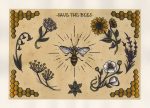As the semester comes to an end, and students scramble around preparing for finals, there are two words that every desperate undergrad is dying to hear: extra credit. A biology professor at Clemson University, Dylan Dittrich-Reed, takes a different spin on extra credit.
In his classes, students can submit creative projects for an end-of-semester boost to their GPA, including everything from poetry and paintings, to a slightly crazier option: tattoo sketches. Even more unbelievable? If he really likes them, Dittrich-Reed turns the sketches into bona fide body art.

Valarie Kiel: What inspired you to create this extra credit?
Dylan Dittrich-Reed: It seems to me that more and more undergraduates at research institutions are rewarded for specializing and narrowing their field of study early. The goal of many students is to choose courses that will help them get into graduate and professional schools, rather than those that expand academic horizons and develop breadth of knowledge.
Science isn’t only about knowing all the right concepts and content; it also involves creativity. I wanted to encourage and reward creativity and artistic talent in students who might not otherwise choose courses that would.
When I was an undergrad at UC Davis, I took an introductory anthropology class. My favorite part of that class was having the opportunity to work on a creative-writing assignment in which we used fiction to discuss topics that we had learned in the class. I want to give my students a similar positive experience blending art and science.
VK: You teach introductory biology courses. Does the extra credit option correlate with the material you teach to your students?
DDR: The instructions for the creative art project are simple: Use art to express any concept that we discuss during the semester. I don’t allow models, diorama or labeled figures. It’s okay if their work for this project isn’t completely accurate. The goal is for them to take what they have learned, and show me what it means for them in an aesthetically pleasing way.
VK: Are tattoo sketches the only form of extra credit you allow?
DDR: Students do not have to only submit tattoo designs. They can submit more traditional visual arts, like paintings, drawings or sculpture. I also have accepted fiction, poetry, board games, video games and song lyrics. The categories have changed from semester to semester.

VK: I think a lot of people would be hesitant to get a tattoo from an extra credit project on their body. What made you do it?
DDR: Tattoos can be simultaneously a very personal and public form of expression. Tattoos tell a story or store a memory that only the wearer knows. At the same time, they are interesting and beautiful and evoke emotions from others. They start conversations and initiate connections.
VK: How often do you give out the extra credit, and what are the qualifications?
DDR: The introductory biology class that I teach is called Principles of Biology, and it is essentially a yearlong course broken up into two semester-long courses. I offer some kind of extra credit each semester, which sometimes is taking surveys or participating in research.
I offer creative-project extra-credit opportunities at least once per year, either the fall or spring. I think the spring semester is better, because by then we’ve covered the full range of introductory biology topics.
VK: What has been your favorite tattoo and story behind it?
DDR: At this point, I’ve only been able to offer the tattoo design category one semester, so most of my tattoos are personal and not student designed. It took me over a year to actually get the winning tattoo from fall 2014.
That tattoo is a jellyfish with DNA double helices for oral arms. The design shows that DNA is integral to all living things; it is the library of life, and we are all just expressions of the information coded in our DNA.

The oral arms are structures that are necessary for the survival and sexual reproduction of many jellyfish, so it is fitting that these structures be visually represented by the molecular information used to make them, and that they help to propagate. Jellyfish are also naturally beautiful animals, so it is also a stunning image.
VK: How do you choose who will be the winner?
DDR: The winning submission must be something I’m willing to put permanently on my body, so I have to find it attractive. I tell my students that the tattoo category is especially subjective. It also must be convertible to a quality tattoo, which typically means simpler shapes with cleaner lines. If a design doesn’t meet these specifications, then I will still consider it for a prize in the visual arts category.
Additionally, the design must include an explanation of how it expresses a biological concept. I ask students to interpret their work for me. A compelling explanation is important, because it provides meaning for the image.














